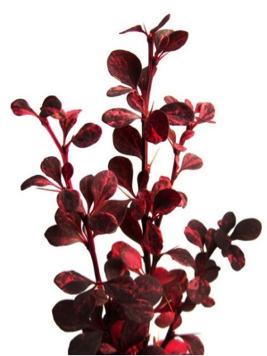

Japanese Barberry: A Prickly Problem
Terry Bonace

It is easy to understand why Japanese barberry (Berberis thunbergii) was and still is widely planted in Beverly Shores. Its foliage runs the gamut of colors from purple to chartreuse, it has attractive red berries that persist in the winter, it is shade and drought tolerant, and its foliage is not eaten by even the hungriest deer. Initially European barberry (Berberis vulgaris) was planted by settlers who used it for hedgerows, the edible, vitamin-C-rich fruit, and yellow dye obtained from the root and branches. (If you pull up a Japanese barberry, you will note the yellow sap in the roots and how it stains your gloves.) When it was discovered that that European barberry was a host for black stem grain rust, a serious agricultural threat to grain, a campaign to eliminate European barberry began in 1918. Japanese barberry, on the other hand, was first introduced into the United States in 1875 and quickly became a popular ornamental
Japanese barberry is invading our forest, aided by its edible berries and prickly branches. The berries are eaten by birds and small mammals who disperse its seeds widely. Large thickets of barberry can occur in the woods not only because of its shade tolerance and seed dispersal but also because deer refuse to browse upon it, eating instead the neighboring plants.
Barberry thickets change the pH (the acidity or alkalinity) of the soil, making it basic (much less acidic is normal for our soils) and this in turn changes the composition of leaf litter and increases the density of earth worms and other organisms that eat the leaf litter. Without the protective leaf litter layer, soil erosion occurs in the area. Researchers have also noted higher densities of adult deer ticks and white-footed deer mice under barberry than under native shrubs. Deer mice, who host the deer tick larvae, have higher levels of larval tick infestation and more of these ticks grow into adult ticks infected with Lyme disease. When barberry is controlled, fewer mice with lyme disease-carrying ticks are present and lyme disease infection rates drop.
Clearly there are many good reasons to get rid of Japanese barberry. Luckily it is easier to remove than many of our non-natives. If the plant is not too abundant, manual removal works quite well, as long as all root fragments are removed. Heavy gloves will be needed because of the thorns. Otherwise, the plant can be treated with herbicides containing glyphosate (Roundup) and/or triclopyr. Look for these ingredients on the product label. Generally products labeled to kill poison ivy and/or briar contain both of these ingredients. Handling herbicides, as in handling all pesticides, requires careful review and compliance with all label directions. The pesticide is most effective when applied in the late summer when fruit is present but in order to be most selective in your application, you can also apply in spring when other plants have not yet emerged. Luckily barberry is easy to recognize from its thorns and berries.
Next month in Sand Tracks we will discuss alternatives to Japanese Barberry. As always, the Environmental Restoration Group (ERG) will be glad to help identify plants for you and make suggestions for native replacements. Don’t hesitate to contact Terry Bonace (tbonace@gmail.com), Hans Lagoni (hlagoni@comcast.net ) or Bill Schaudt (blschaudt2@gmail.com) for assistance.